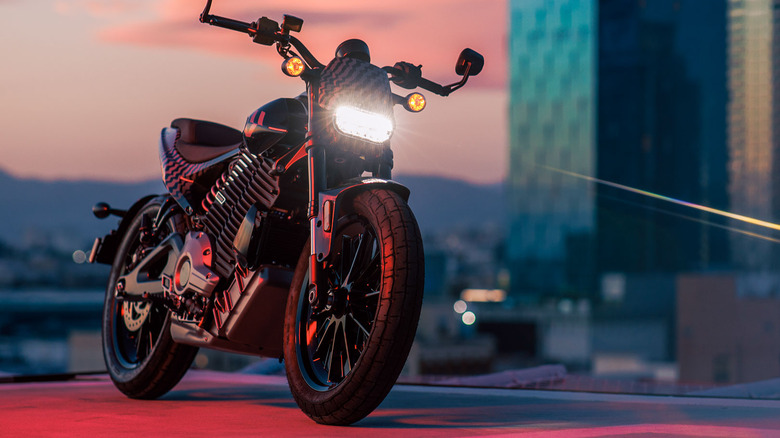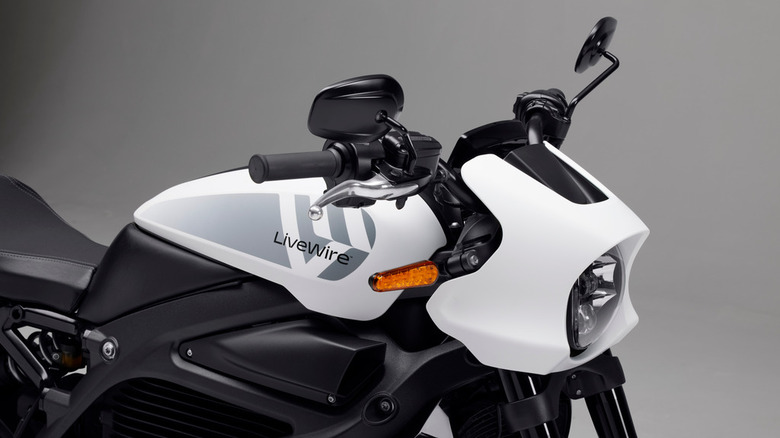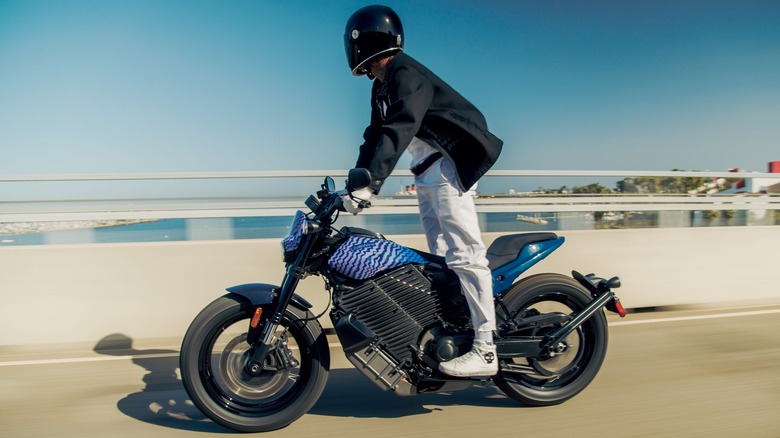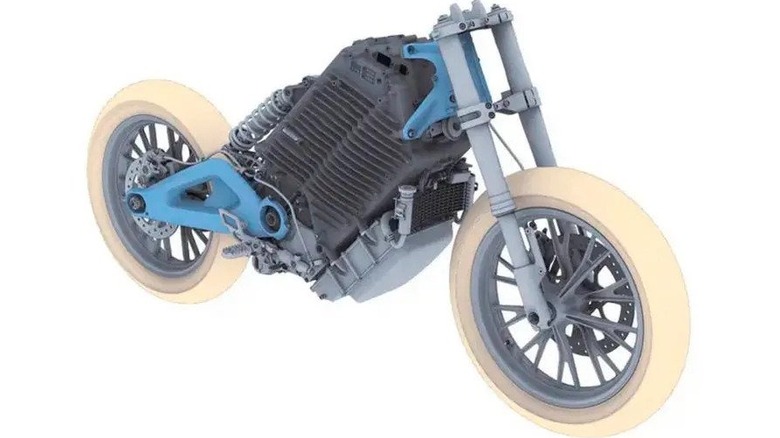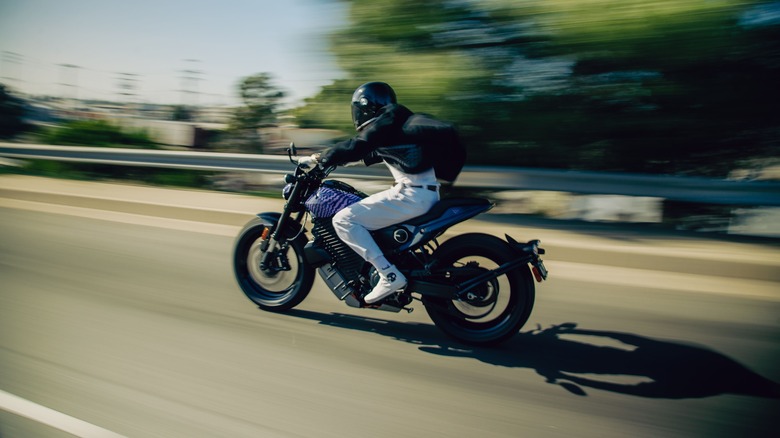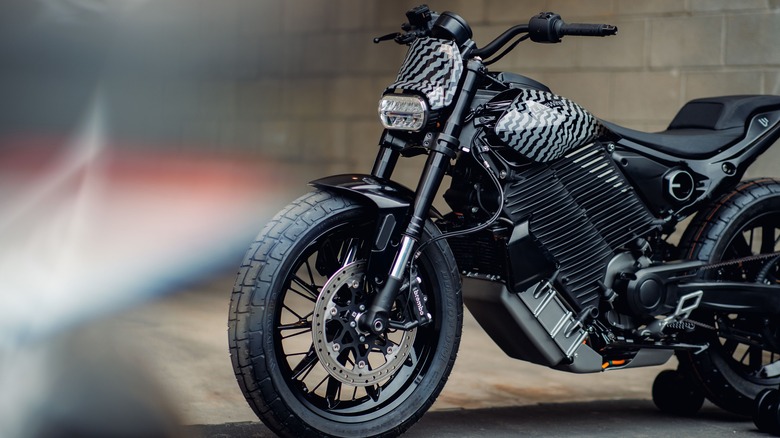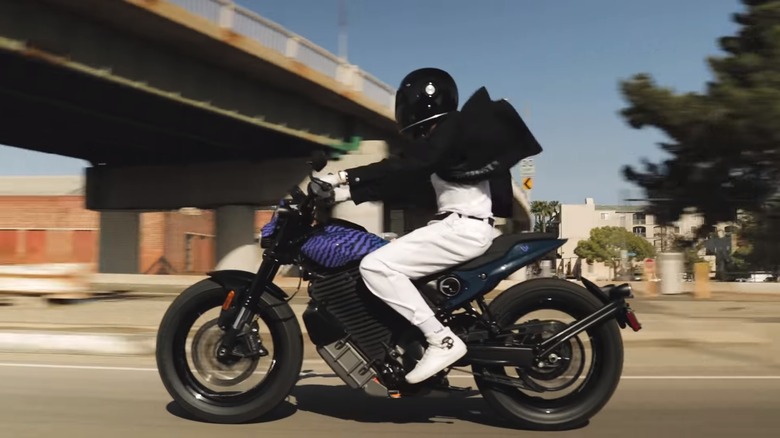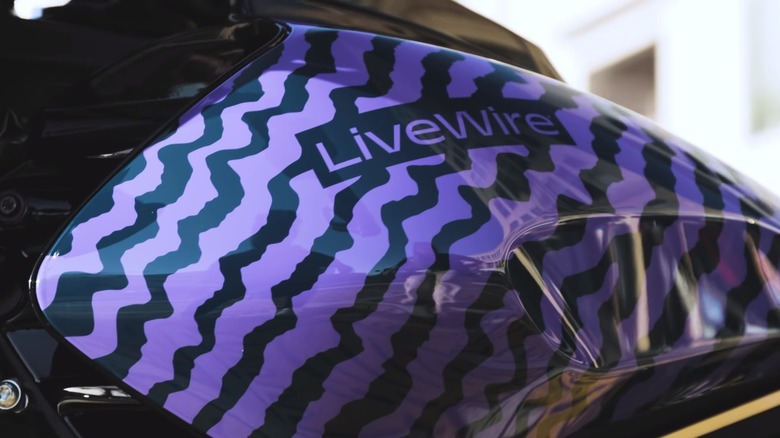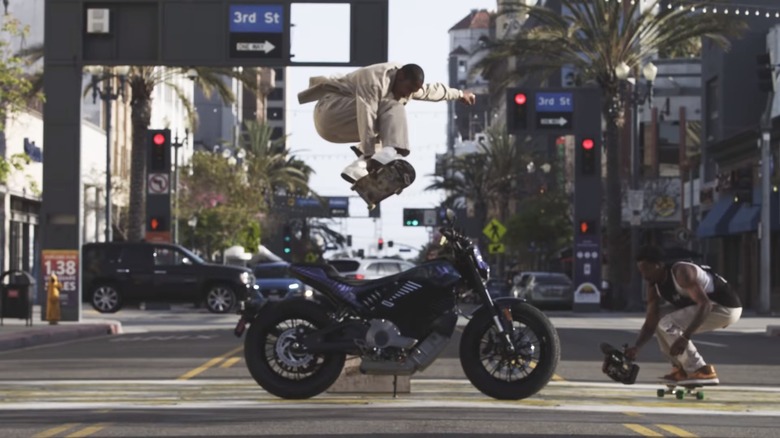10 Coolest Features Of Harley-Davidson's New LiveWire Electric Motorcycle
Harley-Davidson has established itself as the world's leading manufacturer of old-school, tough-guy motorcycles, but it has a problem. By the latter part of the 2010s, most of the riders who wanted a Harley had already bought one, and sales numbers were on a significant decline. Just like every other part of the transport industry, the future of motorcycles looks likely to be powered by electricity. But, launching an electric Harley would fly directly in the face of the loud, proud, and brash imagery that the brand had been relying on to sell bikes for decades.
Rather than try and change the course of the main Harley-Davidson brand, the company decided to launch a separate sub-brand called LiveWire. While the original LiveWire bike went on sale in 2019, it took until 2021 for the brand to become officially separated from the main Harley-Davidson line. Now, the newly-established electric bike manufacturer is looking to flesh out its lineup, and it recently announced a second model, called the Del Mar.
Smaller and cheaper than the LiveWire One
The initial electric motorcycle available from Harley-Davidson was simply called the LiveWire, but with its sticker price of $29,799, it failed to draw much interest from potential buyers. It was simply too expensive, and so when Harley separated from the LiveWire brand in 2021, a new, cheaper model was launched. Called the LiveWire One, the bike started at a still-pricey $21,999, although federal tax incentives were able to bring that price to less than $20,000.
The new Del Mar is even cheaper than the One, in an effort to attract a wider range of customers. The compromise, however, is that the Del Mar looks set to have a smaller range, less power, and slower acceleration than its flagship stablemate. While the One was targeted more at hobby or weekend riders, the Del Mar seems to be angled more towards urban commuters, who won't mind a slightly shorter range or fewer horses to play with.
Target price of $15,000
To entice those more cash-conscious urban riders, Harley-Davidson has said that it is targeting a $15,000 starting price when the Del Mar goes on general sale in 2023. However, a limited run of "Launch Edition" Del Mars was made available for pre-order, with a price of $17,699. It's critical that LiveWire gets the price point just right for this higher-volume motorcycle, as it will set the standard for what buyers expect from the brand's price structure in the coming years.
Set the price too low and the company risks devaluing the technology that powers the bike, which could threaten future profit margins if production costs increase (which, given the state of the energy market at the moment, seems quite likely). However, too high of a price will make the Del Mar just another novelty, out of the reach of most everyday riders. Harley has already admitted that it only sold 500 units of the LiveWire One in 2021, and it's going to need to shift an awful lot more than that if it wants to build a future-proof brand. Keeping the price to around $15,000 sounds like the right compromise, but it remains to be seen if that figure will creep up when the mass-market version is launched.
Built on LiveWire's Arrow platform
Part of the reason that the new bike is able to be considerably cheaper than the original model is that the Del Mar shares its predecessor's Arrow platform. The initial development cost of creating an entirely new platform is always considerable, but by building all of its LiveWire bikes on the same foundations, Harley should keep costs down in the long run. The Arrow platform began development in 2017, and it will reportedly spawn a number of further models in addition to the Del Mar.
These models will cover a broad range of performance and styles, per Motorcycle News. This is made possible thanks to the platform's modular design, which features a central battery pack that also doubles as a monocoque frame. Various motors can be bolted to the rear of the frame, and a variety of battery sizes can be squeezed into the central pack. According to Motorcycle News, these will range from 50-volt packs to units with more than 400 volts on tap.
80 horsepower electric motor
Every Del Mar comes with a motor capable of producing 80 horsepower, a little less than the flagship LiveWire One, which produces 105 horsepower. It might pack less horses, but the Del Mar's reduced weight should mean that performance isn't greatly impacted. Bennetts reports that the LiveWire One weighs 255 kg (562 lb), while the Del Mar will weigh "less than" 200 kg (441 lb), although so far, Harley has remained tight-lipped on the exact number. This reduced weight was partly achieved by integrating some of the bike's components, including the onboard charger, into a new unit that's mounted to the battery case, reports Engadget.
With the modular construction of the Arrow platform, it's plausible that a higher-powered version of the Del Mar could be released at a later date, with very little development needed on Harley's part. Although, this will likely be dependent on the reaction from customers, and whether there's any perceived demand for extra variants. As it stands, the 80 horsepower motor is the only option, and there's been no official indication that will change before the model's main launch in 2023.
0-60 in less than four seconds
Very little is yet known about the performance specifics of the new Del Mar, but it has been confirmed that the bike's 0-60 mph time will come in at around 3.5 seconds. That's roughly half a second slower than the LiveWire One, but it's still no slouch. The top speed hasn't been disclosed yet, but it'll almost certainly be lower than the One's official top speed of 110 mph. In a review of the One, Ultimate Motorcycling noted that although they managed to get the bike over its official top speed, registering 115 mph at one point, acceleration noticeably tailed off at the 80 mph mark.
That suggests that although the Del Mar might be able to get up to highway speeds, it probably won't be able to confidently overtake faster vehicles. While that might not be an issue for most urban commutes, it does somewhat limit the bike's practicality for longer trips.
A range of 100 miles
Of course, longer trips won't really be on the cards anyway, as the bike's slightly underwhelming range of 100 miles means that it's really only good for suburban and city journeys. This wouldn't be so much of an issue if the bike was compatible with DC fast charging, but it isn't. It can only be charged at Level 1 (110V/15A) or Level 2 (220V/30A), with no word from Harley yet on how long a full charge will take.
That's a shame, as the LiveWire One was capable of charging from 0 to 80% in just 40 minutes with DC charging, and from 0 to 100% in just an hour. It's presumably one of the sacrifices that Harley had to make to keep the cost of the Del Mar lower, but it does limit the bike's appeal among more time-strapped commuters. CycleVolta estimates that the Del Mar could take six or seven hours to charge from 0 to 100% on a standard 110V/15A outlet, so it'll have to be left overnight in most cases.
Built-in GPS and over-the-air updates
As is the case for many new vehicles, the LiveWire Del Mar was developed with increased connectivity in mind. The bike will be able to connect to a cellular network to receive over-the-air updates to fine-tune its performance capabilities and add new software features. Harley-Davidson hasn't confirmed this, but there are also likely to be tweaks made to the bike's battery management software, shaped by the usage data from vehicles already on the road. This should help keep the Del Mar cutting-edge a lot longer than a traditional motorcycle.
Also included is built-in navigation, although not much has been disclosed about the specifics of this yet. The LiveWire One is compatible with both iOS and Android through Bluetooth or a USB connection, and there's a voice recognition function for easy infotainment controls. While it's not been confirmed yet, it's probable that the Del Mar will feature a similar setup, alongside the usual control interfaces.
A sold-out launch edition
With its meager sales of just 500 units from 2021, there were some doubts over how much demand was out there for the LiveWire brand. But, it seems those fears were unfounded, as the limited-run "Launch Edition" of the Del Mar sold out in an astounding 18 minutes upon its release. A total of 100 examples of this $17,699 first edition will be made, and each one will come with unique paint and wheel designs. The bikes will be hand-painted by CPV, a process that reportedly takes five days to complete.
Two colors were available for the launch version of the Del Mar, either Comet Indigo or Jasper Gray. To really highlight how unique each example is, every unit will have its edition number painted onto the battery casing, reports Cycle World. Although every example of the Launch Edition was spoken for in record time, there's still no official word from Harley about exactly when the bikes are set to make their way into the hands of customers. Orders closed in May 2022, and at the time of writing, the only clue is that buyers can expect their new rides sometime in "Spring 2023," if all goes to plan.
Available from 2023
While it remains unclear how soon into 2023 the Launch Edition Del Mar will arrive, Harley has claimed that by the end of that year, orders will be open for the regular edition of the bike. That sounds like good news, but it's not a certainty yet. A regulatory compliance issue with a supplier forced Harley to shut down production earlier in 2022, albeit only for a couple of weeks. With global supply chains now more fragile than ever, it's likely not to be the only hiccup that the company encounters while bringing the Del Mar to production.
Once this second model starts to make it into the hands of customers, it remains unknown what Harley-Davidson's next steps might be. There have been plenty of rumors that a family of models will be on the way once the Del Mar is out of development, with some suggestions that the company plans at least four different bikes within the next few years. Expanding the range would certainly help LiveWire attract more customers, although in order to make that move profitable, the brand will need to increase its yearly sales figures by an order of magnitude.
The key to Harley-Davidson's future
While launching this new electric motorcycle, Harley-Davidson is also busy trying to figure out what to do with its iconic main brand. The entire point of creating LiveWire as a spin-off sub-brand was to avoid the stereotypes that are associated with the Harley-Davidson name, and the legal side of that process of separation isn't complete yet, according to a report from Jalopnik. Any complications could potentially lead to delays for both Harley and LiveWire.
The other issue facing the Del Mar and the LiveWire brand at large is the emergence of several key rivals. Emerging startup Zero has already made waves with its range of bikes, including the top-spec SR/F, which packs a similar amount of horsepower to the LiveWire One, yet has double the range. The 2022 SR also features the ability to charge at public EV stations, making it a lot easier to charge than the Del Mar for anyone who doesn't have a garage to leave their bike in overnight. Japanese rival Kawasaki is also looking to launch two new low-cost electric bikes soon, although not much is known about them yet. With an ever-increasing field of rivals, the Del Mar will have its work cut out to convince buyers it's worth the cash. It has the potential to be a strong seller on paper, but it remains to be seen whether the market will agree.
